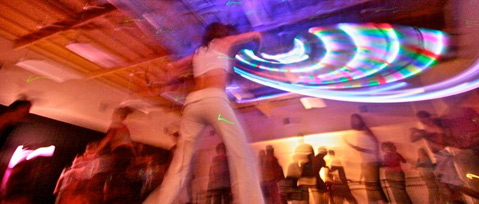Dance Tribe Offers Prayer in Motion
Weekly Freeform Dance Gathering Flourishes

It’s 11 o’clock on a bright Sunday morning, but the building is dimly lit. Down the hallway are giant double doors leading to what I’m told is a sacred space. Inside is a shrine, where candlelight flickers over the figures of deities, and nasturtium blossoms float in a bowl of water. As my eyes adjust to the darkness, I take in the rest of the cavernous room, where flecks of green light smatter the floor like stars. The warm notes of a Native American flute morph into the hypnotic pulse of electronic trance music.
I am here for Dance Tribe, the weekly gathering that many participants describe as a form of prayer.
Dance Tribe has met every week without fail since organizers Lamara Heartwell and Ishmiel Lounsbury launched it in April 2009. On an average Sunday morning, between 50 and 70 people come to dance. There’s no instructor guiding the movements, and talking is discouraged. Instead, participants are encouraged to slip off their shoes at the door and let the music move them.
Lounsbury, a father of three and owner of a drum-making business, discovered freeform Sunday morning dance gatherings in Santa Monica in the mid 1990s, and wanted to provide something similar in Santa Barbara. He sees Dance Tribe as a place for spiritual connection and healing. “I don’t know if ‘church’ is quite the right word for it,” he said, “but it’s a place to heal, and move your body, and express yourself physically.” Heartwell, who works in somatic or body-centered psychology, noted that Dance Tribe is part of a nationwide movement. “Thousands of people are waking up to this way of being alive in their bodies,” she said. “We grow up in this culture conditioned to be in our heads most of the day. I’m passionate about all of us living more embodied lives.”
Both Heartwell and Lounsbury talk about Dance Tribe as a “journey” facilitated by the deejay, who uses music to build the energy in the room from a meditative state to a wild, rhythmic dance and back down again over the course of two hours. They work closely with deejays to ensure a certain kind of experience for their dancers — an experience they refer to with words like “transformational” and “ecstatic.”
The notion of using dance to achieve ecstatic states isn’t a new one; from the spinning of the Whirling Dervishes to the Adumu or jumping dance of the Maasai warriors to the haka of the Maori, humans have long used dance to achieve altered states of consciousness. In the late 1970s, American dancer Gabrielle Roth developed the 5Rhythms structure of guided improvisational dance, in which participants are led along a “wave” through states she refers to as “flowing, staccato, chaos, lyrical, and stillness.” Like many similar gatherings around the country, Dance Tribe is loosely based on Roth’s methods.
Though interaction isn’t required, some Dance Tribers also practice contact improvisation, an un-choreographed dance where partners take turns bearing each other’s weight.
Whether or not they’re actually touching or even making eye contact, Dance Tribe participants say they feel profoundly connected. Lisa Citore, who has been attending Dance Tribe regularly for the past three years, says she keeps going back for the ritual and the sense of connection. “When I first started, I was going through some life changes that were hard, and sometimes I would be dancing and sobbing at the same time,” she said. “Now I feel like I’m holding that space for others.” Citore particularly appreciates the end of each session, when dancers form a circle and each offers a word or short phrase.
Like Citore, general contractor Larry Bilow has been coming from the start. “At Dance Tribe, I drop into the music, and I allow it to move me,” he said, adding that the social connections are central for him. “When you try anything new, there are fears and people put up walls, but those have fallen away, and now we’re like a family; people laugh and cry together. That’s very cool and fairly rare.”
It may be rare, but Dance Tribe is not the first improvisational dance community in Santa Barbara. Between 1978 and 2011, an intergenerational dance jam known as Dance Away was held on Friday nights at the Unitarian Society. In recent months, Dance Tribe has launched a Friday-evening event that they hope will attract some of the longtime Dance Away-goers, as well as new participants.
If Sunday morning Dance Tribe takes the place of church for some, Friday nights offer an alternative to the nightclub scene. “Say you want to go out dancing, but you don’t want the environment of the unconscious pickup, or the alcohol,” Lounsbury said. “This is a safe container.”
Yet as in a nightclub, time seems to warp at Dance Tribe. At some point, my notebook and pen abandoned near the door, I find myself leaping through the space, whirling in circles, then collapsing in a corner to roll on the floor. I’m vaguely aware of the 50 or so dancers who now fill the room, including a man doing a handstand nearby, and a young boy spinning a hula hoop over his head. I’m totally sober, except I don’t feel that way. I feel unnaturally … ecstatic.
Is Dance Tribe for everyone? “No,” Lounsbury said at first, then reconsidered. “Well, actually, I think it is. Some people just haven’t figured it out yet.”
4•1•1
Dance Tribe takes place Friday nights from 8:30-10:30 p.m. and Sunday mornings from 11 a.m.-1 p.m. at the Gail Towbes Center for Dance (2285 Las Positas Rd.). Entrance is $10, or $15 for both Friday and Sunday. For more information, email info@sbdancetribe.com or visit sbdancetribe.com.



